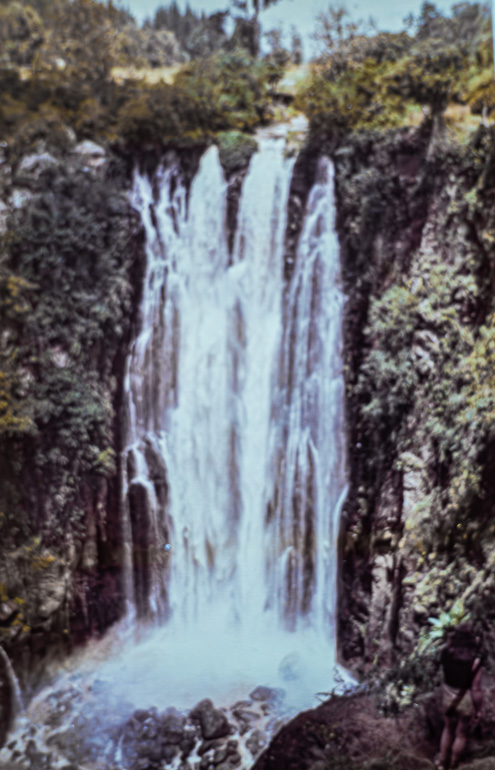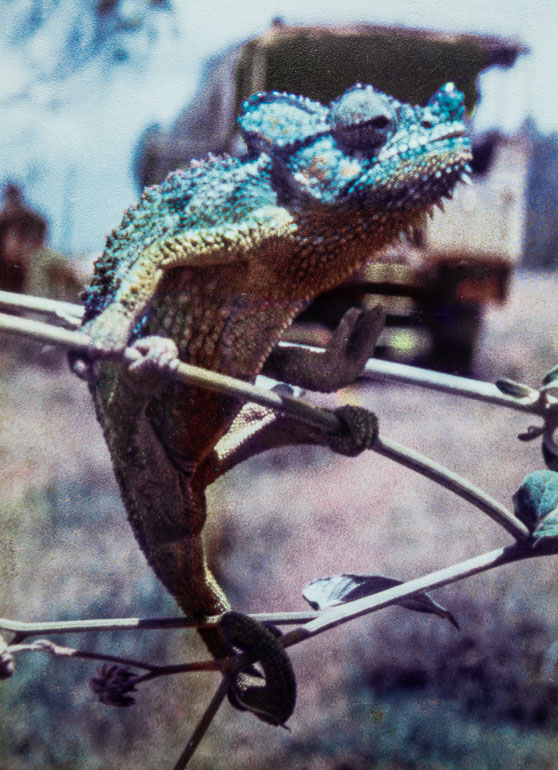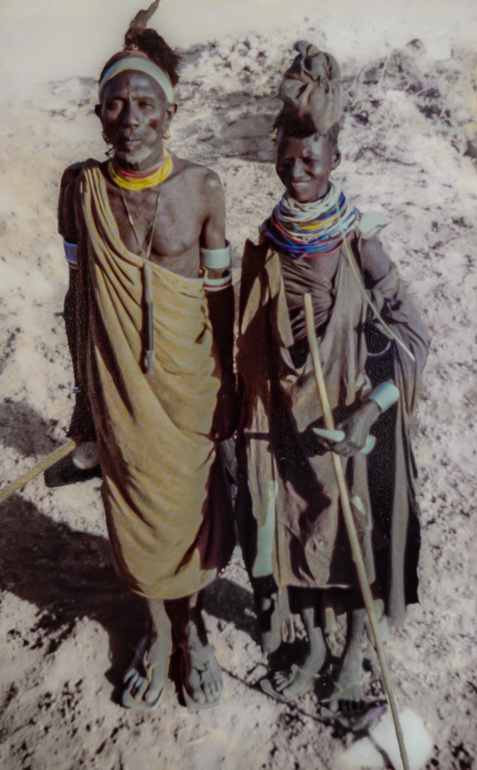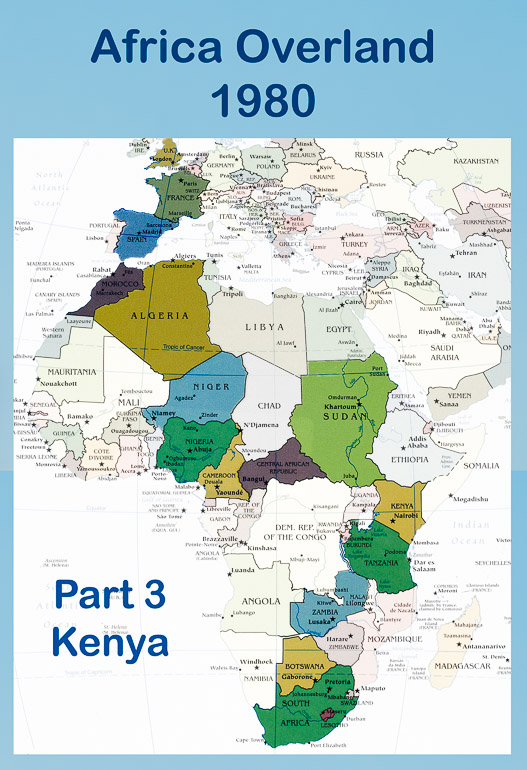

This is the third instalment of a four-month trans-Africa trip from Johannesburg to London that I did with Exodus Expeditions in 1980, travelling by truck and camping. We were not sightseeing, though we did see some incredible sights. Our goal was simply to get through Africa by whatever route was open. You can read the first instalment here, and the second here.
Nairobi is a blur. We’re hardly there at all, and there’s no time for sightseeing. It’s most of a day’s drive from Arusha in Tanzania, through the border and into Kenya, and then straight north to Nairobi, Kenya’s capital and biggest city. We stay a couple of nights in a hotel, parking the truck in the hotel grounds. We pick up four more people making a total of ten of us, plus Craig, our expedition leader, and Brett, the co-driver.
After already being on the road together for over three weeks, the six of us have settled into a routine, and have begun getting to know each other. Four more seems like a lot; the truck feels smaller.
I have two enduring memories of Nairobi. The first is of Helen, one of the new people, dressed in a designer safari suit, waltzing up to the back of the truck and announcing I’d like a non-smoking seat please. I’m astonished none of us actually laugh out loud. It’s a noteworthy beginning.
The name Nairobi comes from the Maasai phrase Enkare Nairobi, meaning ‘place of cool waters’, but it is anything but cool for us. My second memory is of a frenzied shopping trip. We’re taken to the main shopping area, pointed towards some shops, and with little knowledge, and less experience, we shop for bulk non-perishable food to augment what’s already on the truck. The assignment is to get as much as we can that will fit into the storage lockers, as it will be many weeks before we have such an opportunity again. Flour, sugar, canned goods, tea bags, instant coffee, milk powder, the list goes on and on. I try to gather together whatever I can to make granola.
Later that day we’re off, out of town as fast as we can, heading northwest to the game parks.
I want to get my disappointment out of the way first. We don’t go to Ngorongoro or Serengeti in Tanzania, and we also don’t go to Maasai Mara in Kenya. These three, with good reason, are the most renowned wildlife reserves in Africa, and the places that attract the most wildlife, and the most tourists. This was as true in 1980 as it is today, though the tourist numbers are vastly different. All three are quite a distance west from the main road north from Arusha to Nairobi, and we’re bound by the date we need to be in Nairobi to pick up the four people who are joining us there. Even so, I remember Craig’s comment to us – something along the lines of: we could go to the big game parks and see many animals, along with many tourists, or we could go to more remote places where we’ll be really lucky if we see a lion. Wait, what? No! Take me to where we’ll see the most wildlife! And yes, in Meru National Park we do indeed see a half-hidden single lounging lion, resting in the shade of an acacia tree a few hundred metres away. Lucky us.
I would rather have gone to one of the bigger parks, even if there were other tourists there. I still feel a bit cheated.
But now for the good stuff.
By late afternoon we’ve set up camp in Lake Nakuru National Park down on the floor of the Great Rift Valley. A rift valley is a crack in the earth’s surface, and the one in Africa is the biggest in the world, extending from Jordan to Mozambique, a distance of 6,400 kilometres (4,000 miles). The earth’s tectonic forces are trying to create new plates by splitting apart old ones; the valley is created by tectonic forces rather than by erosional forces as most valleys are. But all I know is that it seems as if I’ve been hearing about this mythical place since childhood – the Great Rift Valley – and here I am at last, first looking over it,
and then down in it. We’re surrounded by bushy grassland and wooded areas. And wildlife! Look, a marabou stork! And over there, sitting, appropriately, on a rock, there’s a rock hyrax! In the thick grasses we see impalas, and water buck,
and preening in the lake
a whole long row of cormorants on a log, and pelicans, and a group of wild pink flamingos, dainty ballerinas with long legs and big beaks.
There’s no one around but us. We’re camped in the wilderness a world way in both time and space from towns and cities and Africa Safari tours.
From time to time we see groups of Maasai. They are a tourist curiosity, though not like they are today. Back then they knew they could sell their beadwork and carvings to foreigners in the towns and villages, but they were still living a largely tribal life, a pastoralist society with settlements mainly in northern Tanzania and southern Kenya. I’m too shy to photograph them; it feels intrusive, disrespectful. I buy postcards instead.
Thomson’s Falls, 74 metres of thundering sparkling beauty, is only a couple of hours from Lake Nakuru and we stop there for lunch,
but the real stars of this show are the chameleons! There are no touts, like I hear there are today, but just a local lad who shows them to us, or maybe it’s Craig, who’s been up and down Africa on the overland route for years and knows things. Anyway we’re all fascinated. Of all the things I thought I’d see in Africa, a chameleon was not one of them.

And then we’re piling back into the truck again for the long drive east to Meru National Park. Even today Meru is largely unspoilt.
We are all in the truck, and paying very close attention. The tension is palpable. We’ve been watching a group of ellies, but it now seems like a big bull may not be so pleased with us and looks like it might charge. Even a truck the size we have is no match for an angry bull elephant. Craig backs the truck slowly away, and we’re all watching, and watching, waiting, holding our breath; slowly, so slowly, moving away. Finally the elephant decides we’re not worth the trouble. Phew, that was close. With a collective in-breath we all remember breathe again.
I will never tire of the surreal experience of wild camping and seeing a giraffe wander by my tent.
Over a couple of days at Meru we see grazing buffalo, herds of zebras and impalas, and a couple of rhinos.
The park is teeming with wildlife, and travelling the dirt roads we become somehow an integral part of it. It’s remote and rugged and unspoilt, and we live our days, and nights, immersed in the landscape.
A half-day drive to the north we come to Samburu National Reserve, with its distinctive Doum palms,
and across the Ewaso Ng’iro River, its twin, Buffalo Springs National Reserve.
Here we see more ellies
and more zebras,
and every wildlife sighting feels like a surprising magical gift.
There’s another heart-stopping moment when it looks like a group of baboons might jump onto, and worse, into the truck, but fortunately they leave us alone and pass on by.
And we get to have afternoon tea at Samburu Lodge. Such civilization! A real table and chairs, and bathrooms!
We are in the land of the Samburu, who share many traditions and customs with the Maasai. Like the Maasai they are pastoralists raising cattle, sheep, goats, and camels.

Heading north now, we drive for two or three days straight, getting the miles behind us. We’re aiming for Eliye Springs and the shores of the great Lake Turkana in northern Kenya, at the northern end of the Kenyan Rift Valley. It is the world’s largest permanent desert lake. It is also known as the Jade Sea, and to the Samburu as Basso Narok, meaning Black Lake.
The land becomes more arid, dotted with giant anthills.
For the first time we come into the land of the Turkana people, living in the remote far north of Kenya. They seem almost untouched by the outside world. And even though Eliye Springs is a bit of a backpacker and overland mecca, we must still appear as strange oddities to them.

We pass by Turkana villages with their characteristic thatch bomas constructed from Doum palm leaves.

Like the Maasai, the livelihood of the Turkana is dependent on their livestock. They raise camels, along with goats, cattle, and donkeys,
and live completely off the animals’ produce (milk, blood, skins and meat). Any money made from the selling of livestock is used to buy goods such as maize, beans, sugar, tobacco, and vegetables. Things have changed somewhat of course; there are now small buildings, and irrigation systems for farming. The town of Lodwar, being the gateway to Eliye Springs, has become more developed.
From Lodwar we travel north for a bit then turn east onto a long stretch of uninhabited dusty sandy dirt road; even today it’s a bumpy ride to Eliye Springs at Lake Turkana. We really have no idea where we’re going, or what we’re going to, but after a couple of hours we pass through the remote village of Eliye Springs and soon after arrive in heaven!
Two whole days in heaven; gentle waves lap the shore, the long grove of palms provide shade, blue water before us, blue sky above. We pitch our tents on the almost deserted beach and settle in. There are some very basic facilities, but they are enough for us.
We get clean, we swim in the clear soothing water, we laze, we soak up warmth and idleness and dazzling sunsets. This lake is a major breeding ground for Nile crocodiles, and the shores are home to scorpions and carpet vipers, but since we do not know this there is nothing to disturb our peace.
Two days later, from Eliye Springs we drive northwest to the border with Sudan (before South Sudan existed as a separate country). We are as far north as we plan to go. From the border we head west.
Next post: Housekeeping – how we make it all work, from cooking to food shopping and stocks, to meal clean up, to staying healthy and clean. How we get firewood and safe drinking water. All the details of how we keep a life on the road functioning. The post following that will be about Sudan.
Disclosure:
1. I’ve changed the names of everyone involved for privacy
2. Obviously any photo with me in it was taken by another member of the group, but I’ve no idea who.
All words and images by Alison Louise Armstrong unless otherwise noted
© Alison Louise Armstrong and Adventures in Wonderland – a pilgrimage of the heart, 2010-2024.

How very fabulous, Alison. Those scenes tugged at the heartstrings.
LikeLiked by 1 person
Thanks Tish. Not surprised to hear this brought back memories for you. It was such an amazing time; one of the best things I ever did.
Alison
LikeLiked by 1 person
🙂 🙂 🙂
LikeLiked by 1 person
I’m with you on this trip. Fascinating. I love the story of the woman in the designer safari suit. I’d love to know how she managed. You got to see some amazing wildlife. A giraffe walking past your tent would be incredible.
LikeLiked by 1 person
Thanks so much Darlene – so glad to hear you’re enjoying my story. It was a pretty incredible time, and the wildlife was amazing. Safari-suit woman did ok. She soon realized it was going to be some serious rough travel and she pulled her weight, but still carried around with her a pretty big sack of entitlement (more to come on that 😂)
Alison
LikeLiked by 1 person
We visited Lake Nakuru, but I can’t imagine how great it must have been back then. In fact most of your trip is unrepeatable now. What a fantastic adventure! Maggie
LikeLiked by 1 person
Thanks Maggie – yes indeed a fantastic adventure, and this was the easy part. Some seriously tough travel ahead in the jungle. It is unrepeatable for sure. People are so much more “westernized” now, for better or worse, and no one goes into Central African Republic these days, with good reason. Our story of that country coming up, but I know if we did now what we did then we’d all probably be dead.
Alison
LikeLiked by 1 person
Yes that’s true there are many counties where it’s not safe to travel like this. You timed it well 😊
LikeLiked by 1 person
Thanks so much for sharing your journey. I’ve done much of the same, but in more recent times. It’s wonderful to read about what is was like 40+ years ago.
LikeLiked by 2 people
Thanks Peggy. I’m enjoying so much going back through all my photos, notes and memories. You did it sometime in the 20teens didn’t you? I’ve been reading a bit about the o’land trips as they are now and they sound amazing, esp the 11 month one you did. Definitely different from how it was 40+ yrs ago, but just as exciting I think.
Alison
LikeLiked by 1 person
Our trip straddled 2009–10. We started in Spain/Gibraltar, travelled south to Cape Town, then north to Nairobi and finally to Istanbul. Yes, just as exciting.
LikeLiked by 1 person
I can’t imagine what East Africa was like all those years ago. Even close to 20 years ago when we were there, it was so much less traveled than it is now. And of course, very few – in any era – have traveled the way you did. And on that note, let me say I can’t wait for the housekeeping post! I’m a sucker for details like that.
LikeLiked by 1 person
Looking back East Africa seemed so relatively untouched when we were there. I’ve looked at some of the towns we went to as they are today and there’s no comparison, plus these days you can do some pretty lovely glamping at Eliye Springs.
It was really rough travel. What I’ve written about so far was the easy part 😳
Ah housekeeping – I’ll do my best, but have no notes, only photos and memories. There are so many details I don’t remember.
Alison
LikeLike
What an adventure.
LikeLiked by 1 person
Thanks Marie. It was a huge adventure for sure; looking back it’s the most wild thing I’ve ever done. None of us really knew what we were getting into. But the whole thing was amazing.
Alison
LikeLiked by 1 person
When we arrived in Nairobi in 1967 from Liberia, it was the height of civilization to us Alison. We even drank the milk!
I remember being down in the Rift Valley when the linkage on our gas peddle broke and we had to wait while a vast herd of Cape buffalo crossed the road in front of us. It seemed like forever. Like you, we were were wary of the elephants. The week before we arrived, a bull elephant had chased down a VW bus and put his tusk through the rear window.
Loving your adventure. looking forward to the next installment.
As for details, I was lucky. When I got back to Liberia, I wrote a detailed letter to my father describing the experience. I still have it. –Curt
LikeLiked by 1 person
I can’t even imagine Nairobi in 1967, let alone Liberia. And drinking the milk seems suicidal 😂
Were the gas-pedal-issue and the buffalo happening at the same time? Assuming if the linkage broke the gas pedal no longer functioned. Fun times.
I’ve seen videos of angry elephants trashing cars like they were tiny toys.
I’m so sad I no longer have the letters I wrote my parents 🙁 It would really help with this project if I did.
Thanks Curt, glad you’re enjoying my African adventure. A *lot* more to come.
Alison
LikeLike
We tied the linkage down, Alison, and would push the clutch down when we had to stop. It was a long time while clutching as the herd made its way in front of us. Made much longer by the experience. 😳 We were able to get back to our camp/lodge where they had a gas station that fixed the link.
I was lucky. My dad kept my letters. I found them when he passed away.
I know, given you are just on the edge of Kenya, now. –Curt
LikeLiked by 1 person
“This lake is a major breeding ground for Nile crocodiles, and the shores are home to scorpions and carpet vipers, but since we do not know this there is nothing to disturb our peace.” Sometimes, ignorance is indeed a bliss.
Even though you didn’t get to see Serengeti, Ngorongoro, or Maasai Mara, it’s nice that you could see all the wildlife in Meru, including a lion! I’m continuously amazed by the way you traveled back then. It must have been real tough — probably still is.
I can’t wait for your post on Sudan. I wonder if you went to what is now South Sudan, or you also ventured up north.
LikeLiked by 1 person
Thanks Bama. Ignorance re the crocs, scorpions, and vipers at Eliye Springs was bliss for sure. We all really relaxed there for a couple of days and it was lovely.
It was incredibly rough travel, definitely the roughest I’ve done. We really had no idea what we were getting ourselves into and it was incredibly challenging, but so worth it.
We only travelled across South Sudan. We didn’t turn north until we were through the central African jungle.
Alison
LikeLiked by 1 person
My jaw just about dropped to the floor when I read about Helen’s introduction in Nairobi – surely she must have had *some* inkling that an overland trip across Africa in those days meant roughing it for real.
I too would have been disappointed about not going to the big game parks, but am glad you saw ellies and giraffes and rhinos while traveling through Kenya. Reading the part about the single lion reminded me of something that happened yesterday at the office. Our editor-in-chief told me he’d said “yes” some months ago to a story pitch about visiting the national park with the highest concentration of tigers in India. But the writer was incredibly unlucky – she didn’t even manage to see a single one!
LikeLiked by 1 person
I don’t know what trip Helen thought she was going on. She soon settled in, and I don’t think the safari suit was seen after that first day, but she did carry around a pretty big bag of entitlement.
We actually saw quite a lot of wildlife. It’s only after the fact and learning about what you can, even today, see in Africa that I began to understand that we could have gone to more densely wildlife-populated places. I’d love to see the great migration one day!
Oh that must have been so disappointing for that writer not seeing any tigers. We did a four game drives in a park in India and didn’t see any either. Darn wildlife! They should just come show themselves! 😂
Alison
LikeLiked by 1 person
Love to hear that even back then there were still people who would come in asking for absurd things like a non-smoking seat on such a trip. And even better that if you don’t know about the Nile breading ground for crocks and scorpions, it’s not such a fear. 😂 yeah I guess not.
LikeLiked by 1 person
Oh Helen was a treat for sure! 😂. I’ll be writing about personalities in the group in the next post – it wasn’t all unicorns and rainbows 😁
There was quite a bit we didn’t know about that could harm or kill us in Africa, but plenty we did know about. Looking back I think we were all incredibly lucky to come through, let alone come through unscathed.
So good to meet you guys! Too bad we couldn’t hook up again. Safe travels.
Alison xo
LikeLike
A shame you missed the earlier wildlife parks, but it seems you saw plenty later on. I had to laugh about Helen and her entitlement. Hopefully she settled in. Sometimes it’s hard traveling with a group.
LikeLiked by 1 person
I travelled in the same way for four months in South America in ’78 with 24 people and we all got along extremely well, had a great time together. In Africa there were 12 of us and we definitely had to deal with some personality clashes. Helen was notable; talk about entitlement. She did settle in, but still managed to rub people the wrong way from time to time.
We did see plenty of wildlife, and at the time I didn’t really know what I was missing out on. It’s only since, and learning amore about the major game parks that I understand that we didn’t get to the best places. Still, east Africa is teeming with wildlife wherever you go.
Alison
LikeLiked by 1 person
You had more of a cross-section of human life in those countries as well, so many villages and cultures. South America would be a wonderful trip to do that too, I’m sure.
LikeLiked by 1 person
A different world. A different time, Alison.
LikeLiked by 1 person
It really was. In many ways it was so untouched then.
Alison
LikeLiked by 1 person
It is really neat to see “back in time” to the way these countries were just before I was born. Of course life doesn’t stay static, but to be the only white people around – as an American tourist, I have frankly never had that experience. I have a very uneasy feeling about the “it would get much worse” comment about going over rivers on cable rafts from the previous post, and I expect the “housekeeping” post to be quite revealing. Ignorance, though, can get you through a lot – I think that’s where “beginner’s luck comes from.” Sometimes a bit of knowledge is a hindrance, not a boon.
LikeLike